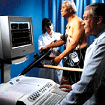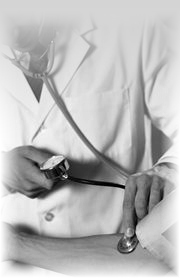 Medical Services
Medical Services
Cardiac Stress Testing
What you should know
 A cardiac stress test helps doctors see how well your heart can cope during exercise, when the body's need for oxygen puts extra demands on the heart. Other names for this test are: graded exercise test, exercise tolerance test, exercise stress test, or exercise electrocardiography (e-LEK-tro-KAR-dee-AH-gruh-fee).
A cardiac stress test helps doctors see how well your heart can cope during exercise, when the body's need for oxygen puts extra demands on the heart. Other names for this test are: graded exercise test, exercise tolerance test, exercise stress test, or exercise electrocardiography (e-LEK-tro-KAR-dee-AH-gruh-fee).
Experience interactive exercise stress testing
Reasons For the Test
Doctors order cardiac stress tests for a variety of purposes. The test helps them:
- Determine whether coronary arteries are clogged.
- Find the cause of chest pain.
- Assess the heart's capability after a heart attack or heart surgery.
- Discover heart disease.
- Set limits on your exercise.
- Detect extra heartbeats (also called arrhythmias [ah-RITH-me-uhs]), during exercise.
- Judge a medicine's capacity to control chest pain or extra beats during exercise.
- The stress ECG is an important test to take before you begin a program of vigorous exercise, especially if you're over 40, have a family or personal history of heart disease, diabetes, high cholesterol, high blood pressure or if you smoke.
How is it Done
The stress ECG is done on a treadmill or bicycle ergometer and takes about half an hour. Electrodes are placed on various parts of your chest and a blood pressure cuff is placed on your arm. During the exercise test, the doctor monitoring the test measures your ECG tracings, heart rate, blood pressure and also watches you for symptoms of heart disease.
Information Used
Your doctor can use the data to diagnose heart disease and also help to establish an exercise prescription with limits that will guide you in a proper exercise program that's safe for you. The doctor may also recommend further testing if there are any abnormal ECG tracings.
Risks
Although stress tests are usually uneventful, problems do occasionally occur. Your blood pressure could fall, causing you to feel lightheaded, or your heart could lapse into arrhythmias. You could even develop chest pain or have a potentially fatal heart attack or stroke. Fortunately, these are all rare occurrences, and you will be watched very closely during the test.
If You're Heading For Your Doctor's Office, A Clinic, Or The Hospital...
Before You Go
- Do not eat, drink alcohol, or smoke for 4 hours before the test.
When You Arrive
- Wear loose clothes suitable for exercise, such as lightweight pants or shorts and a shirt. Wear socks and footwear with rubber soles, such as walking, jogging, or tennis shoes.
What to Expect While You're There
You may encounter the following procedures and equipment during your stay.
- Taking Vital Signs: These include your temperature, blood pressure, pulse (counting your heartbeats), and respirations (counting your breaths). A stethoscope is used to listen to your heart and lungs. Your blood pressure is taken by wrapping a cuff around your arm. The staff will take your vital signs before you begin exercising, several times during the test, and after you finish.
- Electrocardiogram (EKG): While you exercise, a number of sticky pads called electrodes will connect you to a machine that makes tracings of the activity in different parts of your heart. You may also be hooked up to a heart monitor, which traces the heartbeat on a TV-like screen.
During the Test
- You will be asked to take off your shirt. Women need not remove their bra, and can wear a gown if they wish. To help the electrodes stick to the skin, hair on parts of your chest or back may need to be shaved. These areas will also be cleansed to remove natural oils. Once the electrodes are in place, you will not feel any electric current from them, although the skin underneath them may itch.
- You'll be asked to exercise on a stationary bicycle, or a motorized treadmill (a machine on which you can walk or jog). The staff will show you how to use the machine.
- Start exercising slowly. If you use a treadmill, the speed and slope may be slowly increased. If you are using a bicycle, the seat and handlebars will be raised or made shorter for you. Do not grip the handlebars tightly. Just use them to balance yourself. Your doctor may slowly increase the force needed to push the pedals. The test will not hurt, but may tire you out.
- A doctor will watch you during this test. Alert him immediately if you start getting tired, have trouble breathing, or develop chest pain.
- When you reach your target heart rate, you will be asked to slow down. Do not stop until the doctor tells you.
- After the test, you can get off the exercise machine and sit down. Your vital signs and heart readings will be taken again during the next 10 to 15 minutes.
After You Leave
Call Your Doctor If...
- You feel light-headed or think you are going to faint.
Seek Care Immediately If...
- You have trouble breathing.
- You have signs of a heart attack:
- Chest pain that spreads to your arms, jaw, or back.
- Nausea.
- Trouble breathing.
- Sweating.
This is an emergency. Call 911 or 0 (operator) to get to the nearest hospital or clinic. Do not drive yourself!
Stress Test Preparation
- Medications: Hold certain medications (Ask your doctor).
- No food for 3 hours before the test. Drinks are okay.
- Wear comfortable clothes and running shoes.
- Women - Do not wear metal in your bra.
- Be well rested.
- No smoking or caffeine for 3 hours before the test.
- Do NOT wear any body oils or lotions.
Please give us at least 24 hour notice if you are unable to keep your appointment as a $25 cancellation penalty will be charged for any missed appointments.
Prime Healthcare Providers is not responsible for the content of any linked site. See our Terms and Conditions.

